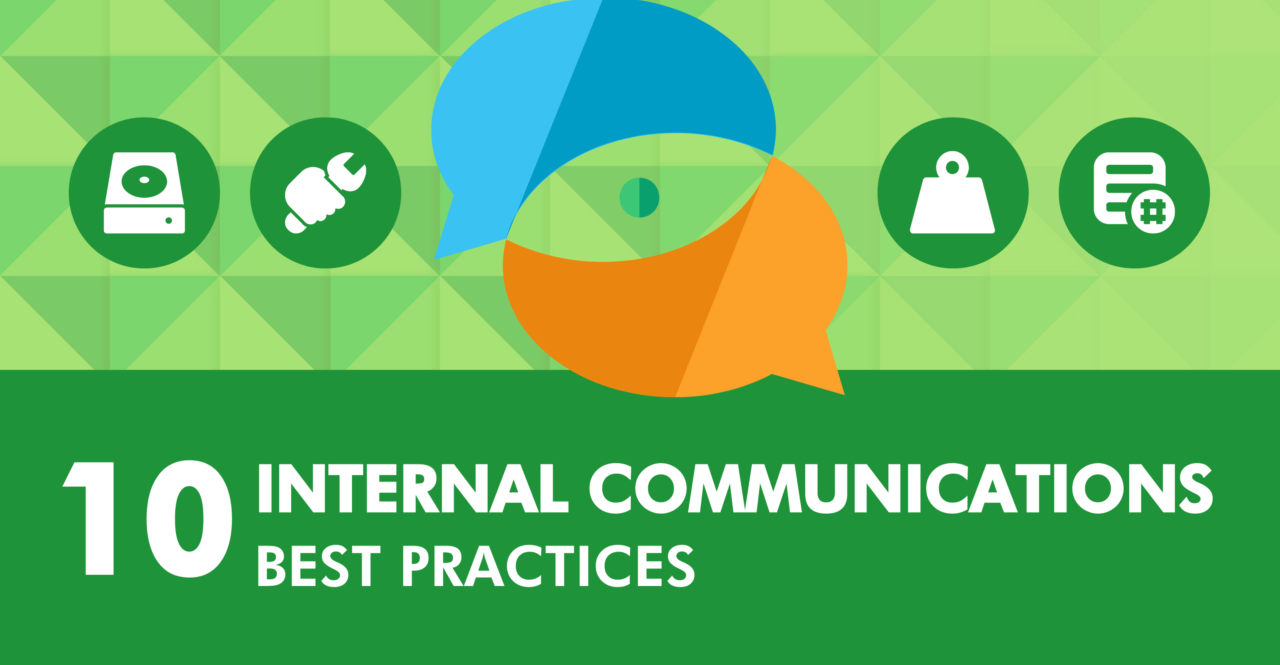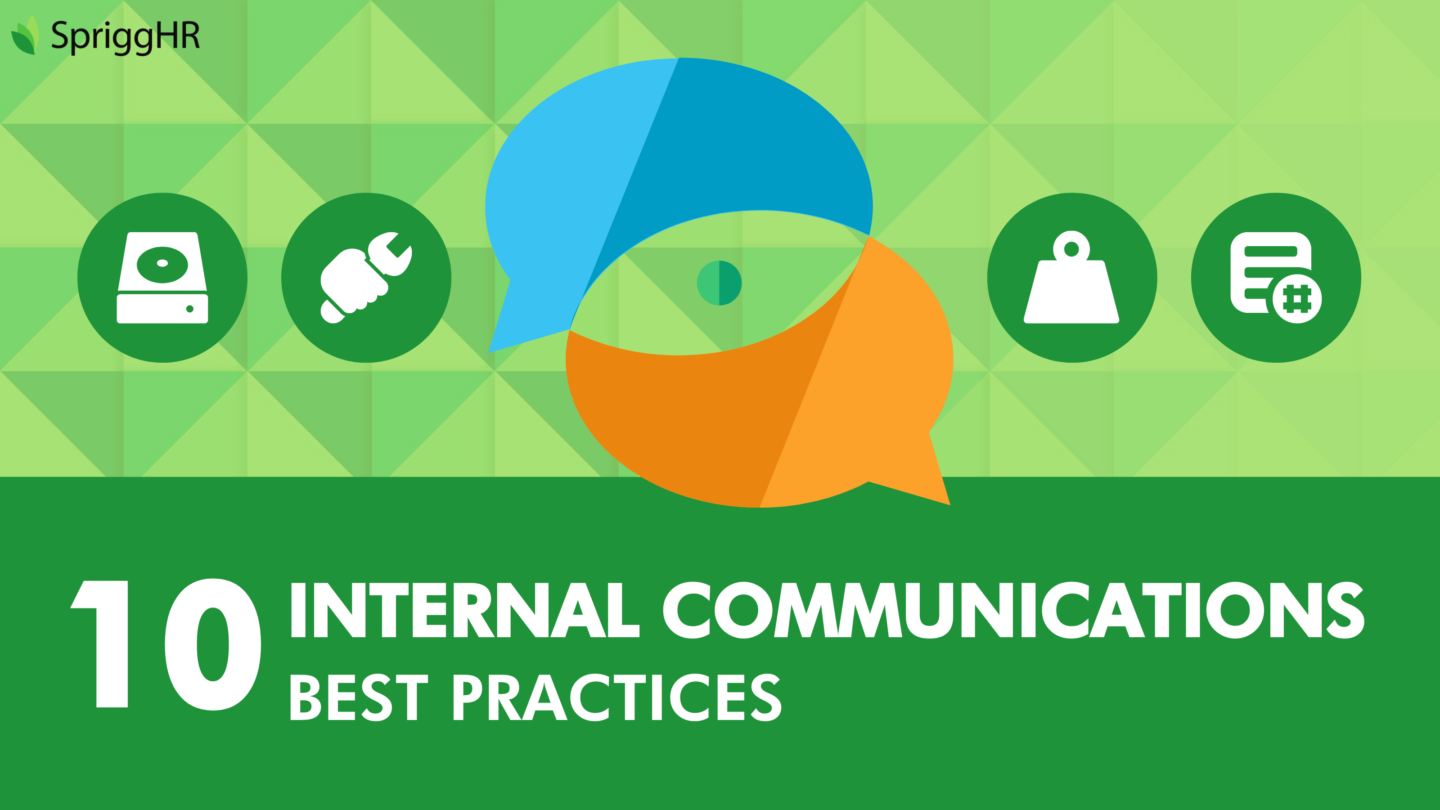
10 Internal Communications Best Practices
The Case for Internal Communications Best Practices
In the modern digital workplace, strong internal communications (IC) is the foundation for success. How a message gets communicated is as important as the message itself. As outlined here, IC is an essential component of an organization’s effort to maintain employee engagement and keep everyone, at all levels, focused on what really matters.
An organization’s culture consists of the company’s goals, values, and practices, and in today’s modern market, company culture can work to give any organization a major strategic advantage. However, that advantage is lost if the organizations fails to effectively transmit these components of their culture. If employees are going to understand and act upon the overarching goals and values of the business, there first must be a strong system of internal communications according to best practices. In short, it’s essential to focus not just on what you’re communicating, but also how it’s being communicated.
Here are 10 new internal communications best practices that can improve your organization’s internal communications strategy, connect your team, and keep everyone engaged and motivated.
1. Envision, Strategize, and Plan Communications
When constructing your internal communications plan, one of the best practices is to first understand the specific communication needs of your organization. Asking yourself the following questions can help guide you towards the best communications strategy:
- What do you want internal communications to do for your team and your organization?
- How will you get there?
- Where does it stand right now? What is working, and what needs improvement?
- How soon would you like to reach your goals?
A well-formulated internal communications strategy can be as simple or elaborate, as general or specific, as is best suited for your organization. The aim should always be to keep the business on track, making the company more efficient in reaching internal communications success.
2. Ensure Consistency in Communication
The absence of a strategic and effective internal communications system is what causes a business to fail in ensuring consistency between external and internal messages.
Especially in larger, decentralized companies, information does not always flow consistently through all departments and levels. This is largely due to the risk of individual managers sharing information at their own discretion also hinges upon their ability to communicate well in the first place.
Aim to continuously provide all employees, at all levels, with a “core story” that frames the organization’s strategy in terms of its overarching mission and values. Maintaining optimal and consistent internal communication relies just as much on the expectations of employees as on the potential effects of the organization. By communicating frequently, consistently, and fairly, you can work to build both trust and buy-in from employees and internal stakeholders alike.
3. Include Metrics Whenever Possible
Regularly measuring an organization’s performance is an effective way to gain insight into the team’s actual work ethic. Using metrics to track progress can be beneficial for employees, making them aware of the specific approaches that communicators use to demonstrate the ROI for their internal communications initiatives.
When involving intermediaries, such as departmental managers, in communicating with staff members, evaluations should include both intermediary engagement and the end-user engagement.
To achieve competitive sustainability in a job market increasingly dependent on technology, businesses can make use of internal communications software to share metrics more conveniently.
4. Provide Channels for Feedback and Ideas
Consistent, two-way feedback is an essential component of any strong internal communications program. Diverse methods and channels are available to organizations, including online software aimed at encouraging open conversation between all members of an organization. Channels for feedback can also be useful when discussing ideas regarding the workplace, products, working procedures, etc., not always limited logistical conversations to in-person meetings and keeping the conversation flowing.
Regularly receiving and sending feedback and ideas in an organization can help an organization to remain aligned to its goals, develop new strategies, create good products and services, improve interpersonal relationships, and much more.
5. Encourage Cross-Departmental Communication and Collaboration
Cross-departmental communication is essential if an organization wants its employees to be able to learn from one another. Holding Q&A sessions or special gatherings between different departments to communicate, collaborate, and share insights is an effective way of achieving this.
As an example, regular inter-departmental Q&A meeting sessions can work to encourage the sharing of knowledge across departments, enhancing overall employee engagement. Additionally, consistent cross-departmental collaboration prevents employees from feeling isolated from one another, making it one of the strongest internal communications practices.
6. Maintain Transparency
Transparency is more than just a business policy; it is an organization mindset. Transparency is a crucial internal communications practice, promoting trust, accountability, and open dialogue within any organization. When employees feel left in the dark on certain matters, this may discourage them from asking clarifying questions and sharing their thoughts and concerns on the matter.
Evidently, not all information can be made available to everyone at all times. However, maintaining some transparency on what is directly influencing an employee’s work efforts can have tremendous effects on the harmony and rapport within the organization.
7. Avoid Communication Overload
Especially for larger and faster-growing companies, many internal communications practices run the risk of causing communication overload. While regular and consistent communication is essential, aim to keep messages simple, brief, and to the point. If larger chunks of information are needed to be sent out, communicate with relatively less frequency. Balancing communicating what is necessary with what your employees can handle at once can help you to cut down on communication overload.
In short, the aim to be to always send the right information, to the right people, at the right time.

8. Share Industry News, Trends, and Insights
Employees are valid contributors to the industry itself. All staff members, regardless of ranking, should be consistently updated on the latest industry news. To accomplish this, you can encourage your employees to share and discuss industry news, the latest market trends, and any other industry-related blurbs.
By keeping employees engaged in the bigger picture, it effectively reminds them that their efforts are part of something larger than their purview. This can be an excellent motivator.
9. Use Internal Communications to Recognize and Praise Success
The importance of employee recognition can never be understated. Consistent acknowledgment and rewards for employees performing well makes all staff members feel that their contributions are valued and appreciated. Recognizing employees’ efforts and contributions through internal communications software can not only boost employee morale, but also maximize the organization’s overall productivity and growth.
10. Promote Employee Resources and Training
Any strong internal communications program should be consistently relaying the benefits and resources that are available to employees. This could include information on a variety of things, from health insurance and dental coverage, to company-sponsored seminars, off-site training opportunities, and career-building workshops.
By using a combination of emails, chats, internal blogs and postings, and in-person team meetings to spread the word, regularly promoting resources ultimately encourages employees to invest in their own personal and professional development through the organization itself.
Internal Communications Best Practices Offer a Competitive Edge
In the modern business world, communication professionals are increasingly challenged to prove the direct impacts of the organization’s mission, vision, objectives, and practices. By improving employee communications, an organization can also improve overall employee performance, which lends itself to outside credibility as well as internal success.
The amount of direct contact that employees have both with their peers and their supervisors plays a crucial role in how they stay motivated, notified, and engaged in what they do. In this digital transformative era of hyper-modern businesses, competitiveness hinges upon the ability to enact change. Especially for larger, more widely distributed workforces, keeping pace with rapid innovation requires strong internal communications best practices that consistently keeps all employees fully aware and informed.






